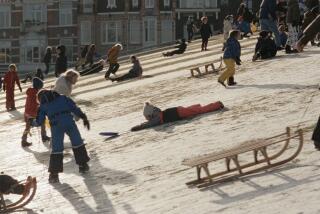Holland’s Wallen Neighborhood Draws Many Tourists, but This One Will Pass
Visitors to Amsterdam love to stroll along pretty canals and explore renowned museums of art. But the city has another, almost equally popular attraction: its Red Light District, which is near the central train station, in one of Amsterdam’s most historic sections.
There, at all hours, tourists can wander past clubs, sex shops and windows where prostitutes in leather corsets and thong bikinis hope to attract the attention of paying clients.
I know many women who have visited the Red Light District--locally known as the Wallen (Wall)-- and who say it’s strikingly clean, safe and even cozy, with quaint gabled buildings in the shadow of the city’s oldest church, Oude Kerk, which dates back to 1300. And surely anyone who has looked at a Victoria’s Secret catalog lately wouldn’t be shocked by the attire of the window prostitutes who rent show space in the Wallen and work in rooms at the back.
What may seem more shocking, at least to the naive, is that, in the Netherlands, the “oldest profession” is legal and out in the open. Thus the Red Light District is a big attraction, even among women tourists. When I was in Amsterdam in August, I didn’t visit it, partly because of a distaste I’ve only now started to understand.
Prostitution has been tolerated in Holland for nearly a century. A law that went into effect on Oct. 1 also made brothels legal in an effort to regulate the country’s billion-dollar sex industry and separate it from criminal activities such as drug and arms selling, according to the Dutch Ministry of Justice.
Inspired in part by recent studies from the Amsterdam-based Mr. A. de Graaf Foundation, which researches prostitution, and the Netherlands Institute for Socio-sexual Research, the legislation also aims to clamp down on coerced prostitution and the use of minors in the sex industry, problems that have persisted despite Holland’s approach to what many people in the U.S. see as a basic social ill.
But the Dutch are different, at once liberal and pragmatic. As far back as 1597, when Amsterdam opened a workhouse for “fallen women” called the Spinhuis (which means “spinning house”) just blocks away from the Wallen, city fathers thought that reform of the fallen should go hand in hand with punishment. More recently, legalization of prostitution, abortion and euthanasia and decriminalization of marijuana have been predicated partly on the belief that punishment and forced eradication worsen social ills. “It seems the world can’t do without prostitutes,” says Dutch senator Hanneke Gelderblom in “Sex, Drugs and Democracy,” a 1998 documentary about Holland. “Let’s have them in a system where they are controlled.”
American visitors to Amsterdam who think this makes sense--at least theoretically--tend to be encouraged by the look and feel of the Red Light District. Though pickpocketing and drug selling still occur, the sex industry seems to be operating in an orderly fashion. By day, the Wallen is a real neighborhood where people live, read newspapers in cafes and shop for groceries. And tourists with little interest in sex clubs like Theater Casa Rosso and the Banana Bar can admire the stained glass windows in the Oude Kerk; visit the Amstelkring Museum, a secret Roman Catholic church during the 17th and 18th centuries, when only Calvinism was allowed in Amsterdam; and read the words inscribed above the entry to the old Spinhuis: “Cry not for I exact no vengeance for wrong, but force you to be good. My hand is stern but my heart is kind.”
Streetwalking, which usually is a pursuit of prostitutes who are illegal immigrants, is not allowed. And the district has its own police station on Warmoesstraat, where officers say tourists, not hookers or their intended clients, are the biggest troublemakers.
To teach people how to behave in the Wallen, Officer Willem Schild wrote a brochure that is now distributed by the police department and put in some hotel rooms. In it, the Red Light District is described as a “small village inside Amsterdam” where “not everything is allowed; there are rules.” Smoking marijuana, drinking alcohol and urinating in the street can get you fined. And though using bad language, shouting and taking pictures of the window women aren’t illegal, Schild warns against them. “Show some respect,” his pamphlet says, in capital letters.
The idea, I suppose, is that women who are prostitutes should be allowed to pursue their work in a civil atmosphere. According to the Mr. A. de Graaf Foundation, there are 20,000 professional prostitutes in the Netherlands, including the window women, streetwalkers (limited to special zones in major cities), sex club performers and escort service workers (who may be high-priced call girls or homemakers). They pay taxes, have the right to pension and health benefits from the state, and have a union, known as the Red Thread. Condoms are routinely used, and government inspectors visit brothels to check on safety and sanitation.
Still, Luceia Brusa, a researcher for the Mr. A. de Graaf Foundation, estimated in 1998 that at least half of Amsterdam’s sex workers may be working under duress, possibly economic or psychological, but duress nonetheless. In the end, this is what seems to me so sad about prostitution: that some women don’t choose it freely. It’s the “oldest profession” only because in a male-dominated world, it has been the one sure way for women without education, money and opportunities to subsist.
This thought has soured me on Amsterdam’s Red Light District, where besides simply wandering, visitors can take tours, some of which include “fashion shows” with hookers in rubber and leather, and striptease instruction from a pro. I don’t know whether this is degrading, as some feminists would claim, or wrong, as moralists feel. But I do know that I can think of lots of better ways to spend my time in Amsterdam.
More to Read
Sign up for The Wild
We’ll help you find the best places to hike, bike and run, as well as the perfect silent spots for meditation and yoga.
You may occasionally receive promotional content from the Los Angeles Times.






